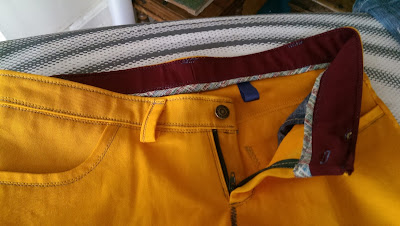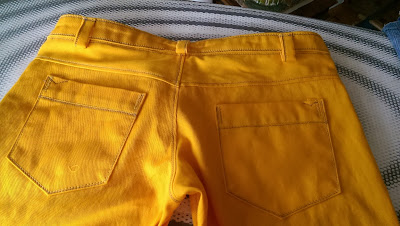Do you remember in school where the answers to all the exercises were stashed in the back of the maths textbook? Peeking was frowned upon because if you followed the right steps in the right process, you'd get the right answer anyway.
One of the things I'm learning (rather cynically) is that sometimes it's good to start with the answer you want to see and work backwards do decide how you can get there. Knowing the answer can help you to choose the right process, and the right steps to achieve it.
Why should I try out a pile of unknown trouser patterns (choosing the process without knowing anything about the answer) when there are a few items already in my wardrobe that I'd consider to be the answer that I want to see? This might be a good way of taking out some of the mystery of more complex garments. I'd love to be able to copy them and just make endless repeats of the ones that work. I have had a particular pair of jeans a long time and they've finally worn out. I like the length, the fit and the size of the pockets. They don't have any darts and the grainline is quite visible after so much wear. I thought they'd be a good starter for my first RTW copy. I took a lot of the copying principles from
Kenneth King's Craftsy class, Jeanius, though really wasn't keen to follow him to the letter. I used muslin, not organza; tracing paper, not carbon paper; and did a lot of marking in Frixion pen.
 |
| Original Front |
 |
| Original Back |
Once all the information was copied from jeans to muslin to paper, I threw it in the laundry and had a blank
canvas muslin ready to copy a new item.
Version 1: Yellow Seagull Jeans
Despite their beauty, these jeans came up 2 inches too big in the waist. There is also some rumpling in the back thigh.
 |
| Version 1 Front |
 |
| Version 1 Back |
Version 2: Sky Blue Octopus Jeans
I compared the V1 pattern to the original jeans. The waistband was too big and the yoke pieces were slightly too big as well. I reduced the side seam above the hip and slashed the yoke to curve it more (which would in turn reduce the waistband by 2 inches).
The fabric is less stiff than the yellow pair, so some twisting and rumpling occurred during the execution, which shows all the way down the back of the leg. I think this compounded any issues that appeared in Version 1.
Here the waistband ended up slightly smaller than expected and the jeans ended up slightly too small all over. Bear in mind that all the adjustments were above hip level. By curving the yoke to reduce the top edge, I think I took a lot of space out of my backside that I really needed to have! Although these are low-rise jeans, they cause quite a few wedgies!
This also had an effect lower down where the outline of my pockets were visible through the front!. I clawed back some space through the seam allowances but it didn't fix the back.
 |
Version 2 Front
Pocket outline on my right thigh (because it's bigger than the left one for some reason) |
 |
| Version 2 Back |
Version 3: Mulberry Seagull Jeans
I put the yoke back to its original shape. Now, Kenneth King's Jeanius doesn't cover copying waistbands at all. The message from the lecture is "don't worry about it, a waistband is just a long thin rectangle - ignore the one on the garment and draft a suitably sized rectangle". I believed him at first, then I did some snooping and pondering. Then I smelled bullshit.
 |
| Correcting the yoke |
After looking closely at the waistband on the original, I spotted the grainline is different between the front and the back. This shouldn't happen if it's a basic rectangle, should it? Measured the top and the bottom edges of the original waistband again. One edge is 34" and one is 35.5". Aha, I'm betting the curve in the waistband is quite important.
This bet is for 3 reasons:
- I have quite a curvy back, so rectangular waistbands often sit a little funny, even if they are the right size.
- Ignoring the rise of these jeans, the difference between my waist and hip measurements is about 10". The distance between waist and hip is about 9"-10", so anything that sits on the body between waist and hip could be curved to match the change in shape more effectively.
- I've seen some pattern cutters argue about matching curves, and more heavy interfaced parts of a garment "pushing" the regular bits around (Patterncutter206 has this video and this video on shirt collars which is relevant, Catina on PatternReview is also a mine of information and ideas) which seems very applicable in this case.
 |
| Adjusted curvy waistband |
Staying on the idea of matching curves - look at how the front two pieces align without a waistband:
 |
| Curvy front pieces |
Surely a straight piece of fabric is just totally inappropriate?
Anyway, this is the finished set of version 3:
 |
| Version 3 Front |
 |
| Version 3 Back |
Those of you still with me will see the back wrinkles are still there. I reckon that this is mostly linked to the length of the leg and drape of the fabric. I like my trousers long, but when barefoot they will meet the floor before my feet do. The sturdy fabric rumples all the way up the back of the leg, whereas a drapier fabric might pool on the floor. This is what happens when I turn up the cuffs:
 |
| Version 3 Back (when they're not too long) |
Better! Though you still need to discount the wearing wrinkles. Voila!
This effect will probably be cancelled out after some real-world wear. If you look again at the original jeans, the back heel has been worn out so the legs won't rumple. The fabric will also probably shrink very slightly over time. Wearing shoes and wearing the jeans at different heights will also have an effect on how much excess length there is in the leg.
I'm finally happy with these jeans and the pattern - I can finally throw away the old pair away and use this as a good pattern to churn out jeans. Copying RTW is also quite addictive, I have a shirt and some more trousers in line ready to make up as well. These have some more interesting details (like darts) and it might take some time to get them right. You'll probably see some updates soon. In the meantime, I'll do some posts on the detail and finishing on these jeans shortly.
Take care for now,
K


































